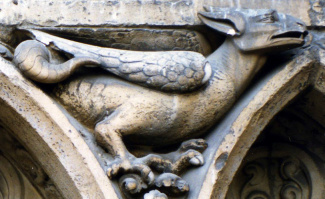Tsepha, found only five times in Scripture, is translated four times as a cockatrice (or its plural version, see Isaiah 11:8, 14:29, 59:5, Jeremiah 8:17) and once as adder (Proverbs 23:32).
And the sucking child shall play on the hole of the asp (in reference to the peace brought by the millennial reign of Christ), and the weaned child shall put his hand on the cockatrice den (Isaiah 11:8, KJV unless stated).
They hatch cockatrice eggs, and weave the spider's web: he that eateth of their eggs dieth, and that which is crushed breaketh out into a viper (Isaiah 59:5).
For, behold, I will send serpents, cockatrices, among you, which will not be charmed, and they shall bite you, saith the Lord (Jeremiah 8:17).
Other than the verses mentioned above, the mythical cockatrice is also found in Isaiah 14:29.

These creatures are said to live in a hole in the ground and are considered poisonous (Isaiah 11:8). They reproduce by laying eggs (Isaiah 59:5) and they possess a deadly bite (Jeremiah 8:17, Proverbs 23:32).
The Bible is silent, however, concerning what "cockatrices" looked like. In myth, however, it is supposedly produced from a cock's egg and which is itself half cock and half serpent. One legend states that this creature could only be killed if it was tricked to view its own reflection.
What Is It?
The majority of commentaries believe what the King James calls cockatrices are actually an adder or a serpent known as a basilisk. Biblical versions vary, however, in how they translate the Hebrew word tsepha. For example, Isaiah 11:8, which mentions the tsepha at the end of the sentence in the KJV, is translated as follows.
The infant will play near the hole of the cobra, and the young child put his hand into the VIPER'S NEST (Isaiah 11:8, NIV).
An infant will play beside the cobra's pit, and a toddler will put his hand into a SNAKE'S DEN (Isaiah 11:8, HCSB).
The nursing child will play by the hole of the cobra, And the weaned child will put his hand on the VIPER'S DEN (Isaiah 11:8, NASB).
According to the 11th edition of the Encyclopedia Britannica, cockatrices were believed "to possess the most deadly powers, plants withering at its touch, and men and animals dying poisoned by its look."
The cockatrice of Scripture might have been a venomous snake that lived in the wilderness of Sinai referred to as a fiery flying serpent.
Rejoice not thou, whole Palestina, because the rod of him that smote thee is broken: for out of the serpent's root shall come forth a cockatrice, and his fruit shall be a fiery flying serpent (Isaiah 14:29, KJV).